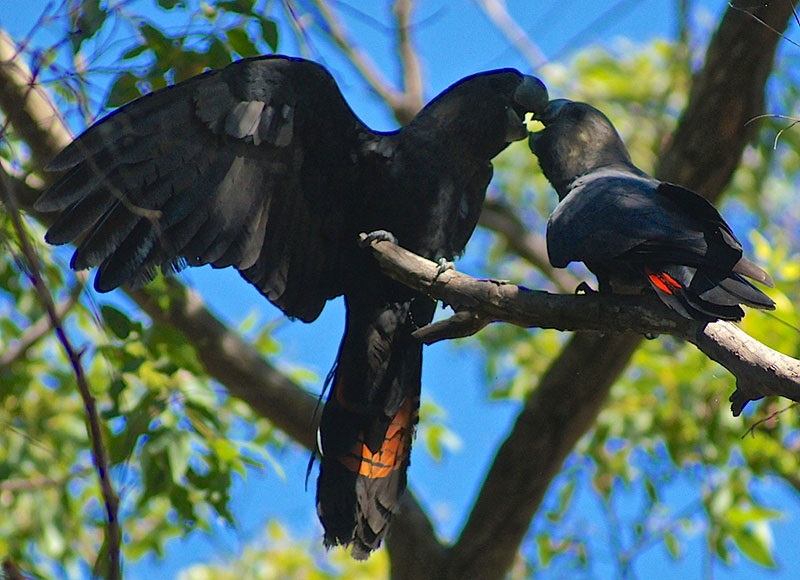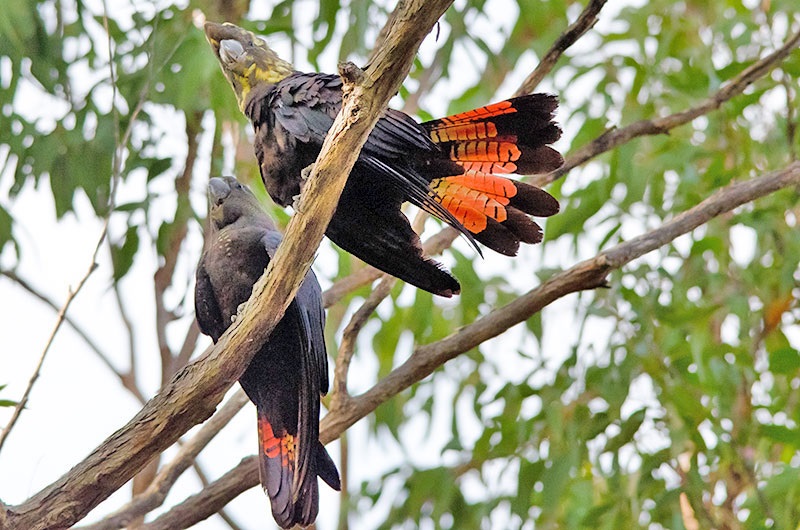Conserving cockatoos and curlews
|

Glossy Black Cockatoo - Bobbi Marchini
|
Tweed Shire has one of the highest levels of population growth in New South Wales. Increased numbers of people, domestic pets and feral animals can impact upon local native wildlife and threatened species.
Council is committed to protecting and enhancing the Tweed’s internationally significant environment for current and future generations and is dedicated to helping lessen the impacts to threatened fauna including the Bush Stone-curlew (BSC) and Glossy Black-Cockatoo (GBC) to ensure the ongoing survival of these iconic species in the Tweed.
Bush Stone-curlew and Glossy Black-Cockatoo conservation

Glossy Black Cockatoo - Gavin Williams |
Active management of the Bush Stone-curlew population on the Tweed Coast since 2012 has resulted in an increase in the local population, which now represents a significant proportion of the Bush Stone-curlew population in NSW. This project will consolidate the conservation gains made to date in recovering the Tweed Coast Bush Stone-curlew population, expand conservation actions into new areas of known habitat and include conservation actions to protect the Glossy Black-Cockatoo.
Glossy Black-Cockatoos are very rare and we are extremely lucky to have them in the Tweed. This type of cockatoo feeds almost exclusively on the seeds of she-oaks, but may also sometimes eat wood-boring larvae. The Glossy Black-Cockatoo mates for life, with pairs maintaining their bond all year round. These birds nest in tree hollows.
Project focus
Council has been awarded a grant by the NSW Environmental Trust to work on a project to conserve Glossy Black-Cockatoo and Bush Stone-curlew. This project will focus conservation efforts for the Bush Stone-curlew and Glossy Black-Cockatoo on the Tweed Coast by managing known key threats including habitat loss and disturbance, and predation (seeking out eggs and nests) and disturbance by domestic pets and feral animals.
The project will focus on engaging with the community about simple measures they can take to protect them including:
- Managing predator species, for example foxes, cats and domestic dogs
- Looking after natural habitat and exploring how to make local gardens/farms Glossy Black-Cockatoo and Bush Stone-curlew friendly
Find out more about Glossy Black-Cockatoos and Bush Stone-curlews.
Bush Stone-curlew and Glossy Black-Cockatoo management in parks
The grant project is currently in its final stage, which involves the implementation of on-ground works aimed at improving the quality of habitat and the safety of these unique and vulnerable birds on public land.
The planned works have been guided by assessments of the breeding season outcomes and the distribution of both species across the Tweed Coast. Five sites were selected to undertake enhancement and protection works, while monitoring population numbers. Works at 4 of the 5 selected sites will begin in May 2022.
Frequently asked questions
What is ‘habitat enhancement’ and when will work start?
Habitat enhancement works will include:
- Planting food and shelter trees to provide increased shade, shelter and feeding trees.
- Seating and educational signage will be placed at sites 1 and 2 (see below) with increased tree planting to provide shade and to encourage passive recreation and bird watching.
- Small, shallow water holes will be installed at each site to provide permanent water for foraging and nesting birds.
- Solar lighting may be installed away from the road to ensure the birds do not forage on adjacent streets and are encouraged to remain within the enclosure.
- A barrier fence will be installed along the road edges to reduce the likelihood of vehicle strike to the chicks.
- Domestic pests will be restricted to keep the birds safe.
Permanent fencing will be installed at Kingscliff (sites 3 and 4 - see below) in May 2022. Initial weed control works will take place at all sites in May and June 2022.
Planting, fencing and installation of habitat enhancement features at the sites is planned to be completed prior to commencement of the Bush Stone-curlew breeding season from August 2022.
Where will habitat enhancement works occur?
- Old Fingal Boat Harbour Park – located on the eastern shoreline of the Tweed River, south of Fingal Headland.
- Jack Bayliss Park (northern end), Kingscliff – located at the northern end of Marine Parade, Kingscliff.
- Cudgen Foreshore Park, Kingscliff – located on the northern shoreline of Cudgen Creek, west of Sutherland Street.
- Cudgen Headland Reserve, Kingscliff – located on the eastern shoreline of Cudgen Creek adjacent to Robert Dixon and Sutherland Point Parks.
What community engagement has taken place prior to habitat enhancement work starting?
On Friday 8 October 2021, Council engaged the community at a workshop at Fingal Rovers Surf Lifesaving Club that was attended by 13 people, representing 6 different local organisations, as well as Council, including:
- Tweed Byron Local Aboriginal Land Council
- Fingal Head Public School
- Fingal Head Community Association
- Tweed Valley Sailing Club
- Fingal Rovers Surf Lifesaving Club
- Fingal Head Coast Care.
On Wednesday 10 November, 2021, Council engaged the community at a workshop at Cudgen Headland Surf Life Saving Club. It was attended by 9 people, representing 2 different local organisations, as well as Council, including:
- Kingscliff Rate Payers and Progress Association
- Kingscliff Community Dune Care.
At these workshops Council’s project team consulted with the community and gathered valuable feedback on how the local community would like their parks to look and feel, whilst conserving the Bush Stone-curlew and Glossy Black-Cockatoo. Community feedback informed the final design of the habitat enhancement work.
Fingal Head Coast Care and Kingscliff Community Dune Care groups have been engaged to provide locally sourced seed stock from their nursery and to take part in the tree planting.
Site signage will provide the vision for the site and describe how it will be used in the future.
Council has partnered with Tweed Holiday Parks to provide seating for birdwatching and relaxation. Permanent interpretive signage will also be installed to inform users of the importance of each site in relation to threatened species and the community.
Why is Council implementing these habitat enhancement works?
The Bush Stone-curlew and Glossy Black-Cockatoo are iconic native bird species both under threat in NSW and require immediate protection interventions.
These birds need the support of the Tweed community so that they don't disappear from the area. The habitat enhancement works will provide areas for the community to see first-hand and appreciate the unique birdlife in their natural habitat.
The Tweed's curlew population does not always choose the best place to nest, so it's up to us as a community to keep them safe in their chosen location.
The Tweed Coast is known as an area of natural beauty. These areas will also highlight our community as one that cares for and protects unique and threatened species.
These works will add to Tweed Shire Council's value of looking after people and places and making a difference, so that our Tweed community is even better tomorrow than it is today.
Why are we doing this for Bush Stone-curlews when they are frequently seen along the Tweed coast?
As a result of this active management, the Bush Stone-curlew population in the Tweed Shire has increased from just one known breeding pair in 2012 to approximately 50 known breeding pairs in 2020. This is unique within NSW, as this bird species is now locally extinct in many regions.
Sightings were recorded at 39 locations during the 2019-2020 breeding season on land managed by Tweed Shire Council.
Monitoring and protection works are ongoing, as the Bush Stone-curlew population in NSW is listed as Endangered, and the local population is still in the very early stages of recovery.
What else does Council do to protect threatened species?
Since 2012 Council staff have been actively working with community members from across Tweed Shire to implement a scientifically rigorous Bush Stone-curlew population monitoring program, and to actively manage and protect nest sites on public land.
Nest site protection works include:
- Fox and feral cat control works
- Temporary fencing of nest sites to prevent disturbance
- Awareness raising activities to encourage leashing of dogs in public places and keeping cats safe at home.
Will there be any changes to community use at the public parks?
There will be minimal changes to community use at the public parks however, the community is advised to be mindful of the changes and see site signage for more information and restrictions.
New barrier fencing will be installed at each site. This will make it safer for park users and threatened species alike. The project will enhance pedestrian access to nature based recreation.
Temporary signage will be installed at each site to inform users of these changes.
New barrier fencing at Robert Dixon Park will restrict pedestrian access to sections of Cudgen Creek. The fencing is part of the habitat enhancement works and will also help to prevent further erosion of the creek foreshore.
Temporary signage will be installed to direct park users to preferred creek access tracks.
Habitat enhancement site maps
Old Fingal Boat Harbour Park
Old Fingal Boat Harbour Park habitat enhancement plan
Old Fingal Boat Harbour Park now with temporary fencing and signage protecting the threatened Bush Stone-curlew nesting area
Jack Bayliss Park
Jack Bayliss Park - north habitat enhancement plan
Jack Bayliss Park – north now with temporary fencing and signage protecting the threatened Bush Stone-curlew nesting area
Cudgen Foreshore Park
Cudgen Foreshore Park habitat enhancement area
Cudgen Headland Reserve
Cudgen Headland Reserve habitat enhancement area